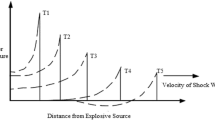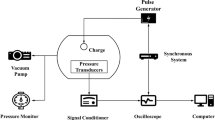Abstract
Insensitive munitions (IM) assessments are required to carry out the sympathetic detonation (SD) experiments. The impact of blast fragments or strong shock waves is the cause of sympathetic detonation. In this paper, a numerical simulation method is developed to predict the sympathetic detonation behavior of fuze explosive trains under the impact of blast fragments, which includes the ignition and growth (I&G) model, the Jones-Wilkins-Lee (JWL) equations of state, and a constitutive relationship. The experimental and numerical results were compared and analyzed, and the validity of the numerical simulation method was proven. The sympathetic detonation behavior of a fuze was studied for a single donor and multiple acceptors. The critical distance was obtained with the presence of fragments using numerical simulation. A critical distance model was developed, which provides a theoretical model for relating the detonation sequence and the placement distance of the fuze explosive train. The simulated results agreed with the theoretical calculations, and thus the model can provide the support for sympathetic detonation experiments.
Similar content being viewed by others
References
J. Lewis et al., The effect of subsurface military detonations on vadose zone hydraulic conductivity, contaminant transport and aquifer recharge, J. Contam. Hydrol., 146 (2013) 8–15.
H. J. Prentice et al., The use of digital speckle radiography to study the ballistic deformation of a polymer bonded sugar (an explosive simulant), Int. J. Impact Eng., 37(11) (2010) 1113–1120.
A. C. Victor, A simple method for calculating sympathetic detonation of cylindrical, cased explosive charges, Propellants, Explosives, Pyrotechnics, 21(2) (1996) 90–109.
N. Al-Shehab et al., Modeling and experimental fragment impact testing of the XM25, Procedia Engineering, 204 (2017) 292–297.
E. L. Baker et al., Insensitive munitions fragment impact gun testing technology challenges, Propell. Explos. Pyrot., 41(3) (2016) 572–579.
J. W. H. Cook, Fracture characteristics of three metals subjected to various strains, strain rates, temperatures and pressures, Eng. Fract. Mech., 21(1) (1985) 31–48.
K. T. Miers, N. M. Al-Shehab and D. L. Prillaman, Fragment impact modeling and experimental results for insensitive munitions compliance of a 120 mm warhead, Procedia Engineering, 204 (2017) 223–230.
L. Chen et al., Study on random initiation phenomenon for sympathetic detonation of explosive, Defence Technology, 9(4) (2013) 224–228.
L. Chen et al., Experiment & simulation of sympathetic detonation tests, Transactions of Bjing Institute of Technology, 29(6) (2009) 497–500.
S. D. Fisher et al., XM982 excalibur sympathetic detonation modeling and experimentation, Proc. of Armament Research Center, Bristol, New York, USA (2006) 1–11.
H. E. Mostafa, W. F. Mekky and W. W. El-Dakhakhni, Sympathetic detonation wave attenuation using polyurethane foam, J. Mater. Civil. Eng., 26(8) (2014) 1–8.
B. Kim et al., A reactive flow model for heavily aluminized cyclotrimethylene-trinitramine, J. Appl. Phys., 116(2) (2014) 2362–2372.
B. Kim et al., Simulating sympathetic detonation using the hydrodynamic models and constitutive equations, Journal of Mechanical Science & Technology, 30(12) (2016) 5491–502.
A. M. Renlund, Reactive wave growth in shock-compressed thermally degraded high explosives, Proc. of American Physical Society Biennial Conference on Shock Compression of Condensed Matter, Seattle, USA, 370(1) (1996) 863–866.
J. P. Lu, M. A. Daniel and I. J. Lochert, Numerical and experimental studies of PBXN-109 sympathetic reaction, Proc. of the 14th International Detonation Symposium, Idaho (2010) 11–16.
J. P. Lu et al., Simulation of sympathetic reaction tests for PBXN-109, Proc. of 13th International Detonation Symposium, Norfolk (2006).
A. L. Howe et al., A numerical study of detonation propagation between munitions, Proc. of the 7th Symposium on Detonation (1982) 1055–1061.
E. L. Lee and C. M. Tarver, Phenomenological model of shock initiation in heterogeneous explosives, Phys. Fluids, 23(12) (1980) 2362–2372.
L. Shuo et al., Experiment and numerical simulation of shock initiation of JH-14C detonation device, Chinese Journal of Explosive & Propellants, 39(6) (2016) 63–68.
N. F. Mott, Fragmentation of shell cases, Proceedings of the Royal Society of London, 189(1018) (1947) 300–318.
P. V. Urtiew et al., Shock initiation of composition B and C-4 explosives: experiments and modeling, Russian Journal of Physical Chemistry B, 2(2) (2008) 162–171.
Acknowledgments
This work was supported by the National Natural Science Foundation of China (NSFC 11802273), the State Administration of Science, Technology and Industry for National Defence, the opening project of Science and Technology on Electromechanical Dynamic Control Laboratory (6142601180404), the Shanxi Province Science Foundation for Youths (201901 D211279) and the Scientific and Technological Innovation Programs of Higher Education Institutions in Shanxi (2019 L0586).
Author information
Authors and Affiliations
Corresponding author
Additional information
Youcai Xiao is a Professor at North University of China. He obtained his Doctoral degree from Harbin Institute of Technology in 2017. His research interests include combustion, energetic materials, abnormal initiation, macro and meso mechanics, and mechanical problems in solid impact. He has published over 15 papers in the refereed literature and presented numerous papers at international conferences.
Rights and permissions
About this article
Cite this article
Xiao, Y., Xiao, X., Fan, C. et al. Study of the sympathetic detonation reaction behavior of a fuze explosive train under the impact of blast fragments. J Mech Sci Technol 35, 2575–2584 (2021). https://doi.org/10.1007/s12206-021-0528-x
Received:
Revised:
Accepted:
Published:
Issue Date:
DOI: https://doi.org/10.1007/s12206-021-0528-x




